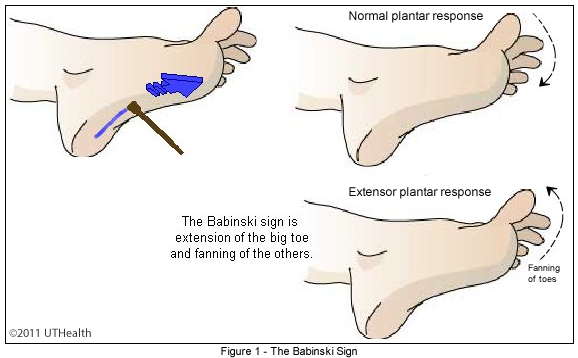Lab 6 (ƒ9) Descending Pathways to the Spinal Cord
Clinical Correlate - Cerebral Monoplegia
 In cerebral monoplegia, following recovery from lesions in the precentral gyrus, the patient suffers from a spastic monoplegia (a paresis of a limb or a part of it), with increased myotatic reflexes and appearance of pathological reflexes. For example, in lesions of the precentral gyrus representing the leg region, the sign of Babinski, extensor response to plantar stimulus is observed. The limb is kept in an extended position and some voluntary movement reappears. The patients are able to stand and walk, although their steps are small and hampered by the existing spasticity.
In cerebral monoplegia, following recovery from lesions in the precentral gyrus, the patient suffers from a spastic monoplegia (a paresis of a limb or a part of it), with increased myotatic reflexes and appearance of pathological reflexes. For example, in lesions of the precentral gyrus representing the leg region, the sign of Babinski, extensor response to plantar stimulus is observed. The limb is kept in an extended position and some voluntary movement reappears. The patients are able to stand and walk, although their steps are small and hampered by the existing spasticity.
In the case of damage to the precentral gyrus area representing the upper limb, the recovery of voluntary movement is often insufficient to allow the patient to grasp objects and use them properly.
The Babinski sign, illustrated, is diagnostic of a lesion of the corticospinal tract. When the sole of the foot is stroked firmly along the path indicated, the normal response is flexion of the foot and toes. The Babinski sign is extension of the big toe and fanning of the others.
